History of Varanasi
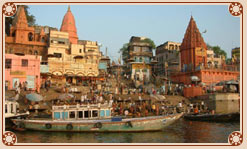 The land of Varanasi (Kashi) has been the ultimate pilgrimage spot for Hindus for ages. Often referred to as Benares, Varanasi is the oldest living city in the world. These few lines by Mark Twain say it all: "Benaras is older than history, older than tradition, older even than legend and looks twice as old as all of them put together". Hindus believe that one who is graced to die on the land of Varanasi would attain salvation and freedom from the cycle of birth and re-birth. Abode of Lord Shiva and Parvati, the origins of Varanasi are yet unknown. Ganges in Varanasi is believed to have the power to wash away the sins of mortals.
The land of Varanasi (Kashi) has been the ultimate pilgrimage spot for Hindus for ages. Often referred to as Benares, Varanasi is the oldest living city in the world. These few lines by Mark Twain say it all: "Benaras is older than history, older than tradition, older even than legend and looks twice as old as all of them put together". Hindus believe that one who is graced to die on the land of Varanasi would attain salvation and freedom from the cycle of birth and re-birth. Abode of Lord Shiva and Parvati, the origins of Varanasi are yet unknown. Ganges in Varanasi is believed to have the power to wash away the sins of mortals.Ganges is said to have its origins in the tresses of Lord Shiva and in Varanasi, it expands to the mighty river that we know of. The city is a center of learning and civilization for over 3000 years. With Sarnath, the place where Buddha preached his first sermon after enlightenment, just 10 km away, Varanasi has been a symbol of Hindu renaissance. Knowledge, philosophy, culture, devotion to Gods, Indian arts and crafts have all flourished here for centuries. Also a pilgrimage place for Jains, Varanasi is believed to be the birthplace of Parsvanath, the twenty-third Tirthankar.
Vaishnavism and Shaivism have co-existed in Varanasi harmoniously. With a number of temples, Mrs. Annie Besant chose Varanasi as the home for her 'Theosophical Society' and Pandit Madan Mohan Malviya, to institute 'Benares Hindu University, the biggest University in Asia. Ayurveda is said to be originated at Varanasi and is believed to be the basis of modern medical sciences such as Plastic surgery, Cataract and Calculus operations. Maharshi Patanjali, the preceptor of Ayurveda and Yoga, was also affiliated with Varanasi, the holy city. Varanasi is also famous for its trade and commerce, especially for the finest silks and gold and silver brocades, since the early days.
Varanasi has also been a great center of learning for ages. Varanasi is associated with promotion of spiritualism, mysticism, Sanskrit, yoga and Hindi language and honored authors such as the ever-famous novelist Prem Chand and Tulsi Das, the famous saint-poet who wrote Ram Charit Manas. Aptly called as the cultural capital of India, Varanasi has provided the right platform for all cultural activities to flourish. Many exponents of dance and music have come from Varanasi. Ravi Shankar, the internationally renowned Sitar maestro and Ustad Bismillah Khan, (the famous Shehnai player) are all sons of the blessed city or have lived here for major part of their lives
Eateries in Varanasi
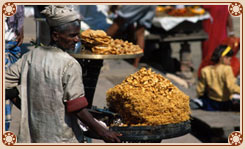 Just like its rich culture and lifestyle, Varanasi is equally famous for its rich variety of foods and cuisines. The sumptuous and delicious but tangy and spicy North Indian food and snacks are the best options to try at Varanasi. However, one can get good Chinese, Italian, Continental and South-Indian food too. There are good number of Byzantine eateries and restaurants in the cities where one can explore for the food that suits one's tastes. The wide variety of mouth-watering sweets and 'chatpate' snacks are just not to be missed.
Just like its rich culture and lifestyle, Varanasi is equally famous for its rich variety of foods and cuisines. The sumptuous and delicious but tangy and spicy North Indian food and snacks are the best options to try at Varanasi. However, one can get good Chinese, Italian, Continental and South-Indian food too. There are good number of Byzantine eateries and restaurants in the cities where one can explore for the food that suits one's tastes. The wide variety of mouth-watering sweets and 'chatpate' snacks are just not to be missed.There is 'paapri-chaat', which plays with your taste buds with its tangy and spicy flavor of ginger and tamarind chutney and the cooling and soothing yoghurt. While talking about the specialties of Benarasi flavors, who can ever forget the sour and sweet 'Langda aam', a variety of mango available in summers and the fragrant 'Benarasi paan' that is often added with aromatic essences such as that of rose and 'supari' (areca-nut) along with other goodies. Chewing this 'paan' seems to be a part of the cultural identity of the people of Varanasi. One can find some good Indian, Chinese, Japanese, Continental, Mexican, Greek and vegetarian South-Indian cuisine and snacks and sweets offers to eat to your fill in the old city or Godaulia, Cantonment area and near Railway Station or Lahurabir area.
Benarasi Masti
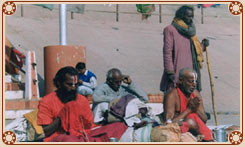
Benarasi Masti - Culture and Lifestyle. Known as the cultural capital of India, Varanasi is famous for its religious and spiritual lifestyle. One of the most important pilgrimage spots for Jains, Buddhists and especially Hindus, Varanasi is situated on the banks of Holy Ganges, which plays an important role in day-to-day lives of the people of Varanasi. Being the oldest living city, Varanasi has been a mute witness to many great historic upheavals and events.
Mythology reins the city and there are many religious places and institutions and places of worship throughout the city where people visit everyday, especially in the mornings and the evenings. On closer look, one can still find the primitive worship cults that are still in practice in the city. The religiosity of the region is evident from the fact that Buddha, Jain Tirthankars, several Shaiva and Vaishnava saints, Kabir and Tulsi were either born here or were associated with the place in a significant way and have spent a long time here.
People of Benaras are known for being the exponents of literature, music, Vedic philosophy, arts, crafts and architecture. Socio-economic aspects of the city are highly influenced by the Ganges and on most of the Hindu festivals people can be seen using the bathing Ghats (river fronts) even before daybreak as an important part of their rituals. In Varanasi, the atmosphere is relaxed in general and we can see people chewing the famous 'paan' and chatting in a laid-back manner. That does not keep Varanasi behind, as is evident from the growing modern industries in the city. Varanasi is also the most ancient seat of education in India (Sarva Vidya ki Rajdhani) and Benaras Hindu University is still famous throughout the world for its scholars. The city is also a seat for Sanskrit and one can still see the Guru-Shishya tradition being followed here at certain places.
Several social and religious customs co-exist in the city and the caste system is still prevalent here. People wear 'Gamcha' (a cotton towel), as they go bathing in Ganga and drink Thandai (a coolant with milk as its base), which have become a part of the cultural identity of traditional ways of Varanasi. Music, drama and entertainment have found a place in the lives of the people. Its dance traditions and vocal and instrumental music is highly developed and one can catch the glimpses of folk drama in the 'Ramlila' organized before Dussehra. Traditional games and sports include 'Akharas', where wrestling or 'kushti' competitions are organized. Foreign tourists love to ride horse-driven 'Ekkas' and cycle rickshaws that are still in use here. Indian medical science of Ayurveda, yoga and meditation are cherished here since ages.
Mythology reins the city and there are many religious places and institutions and places of worship throughout the city where people visit everyday, especially in the mornings and the evenings. On closer look, one can still find the primitive worship cults that are still in practice in the city. The religiosity of the region is evident from the fact that Buddha, Jain Tirthankars, several Shaiva and Vaishnava saints, Kabir and Tulsi were either born here or were associated with the place in a significant way and have spent a long time here.
People of Benaras are known for being the exponents of literature, music, Vedic philosophy, arts, crafts and architecture. Socio-economic aspects of the city are highly influenced by the Ganges and on most of the Hindu festivals people can be seen using the bathing Ghats (river fronts) even before daybreak as an important part of their rituals. In Varanasi, the atmosphere is relaxed in general and we can see people chewing the famous 'paan' and chatting in a laid-back manner. That does not keep Varanasi behind, as is evident from the growing modern industries in the city. Varanasi is also the most ancient seat of education in India (Sarva Vidya ki Rajdhani) and Benaras Hindu University is still famous throughout the world for its scholars. The city is also a seat for Sanskrit and one can still see the Guru-Shishya tradition being followed here at certain places.
Several social and religious customs co-exist in the city and the caste system is still prevalent here. People wear 'Gamcha' (a cotton towel), as they go bathing in Ganga and drink Thandai (a coolant with milk as its base), which have become a part of the cultural identity of traditional ways of Varanasi. Music, drama and entertainment have found a place in the lives of the people. Its dance traditions and vocal and instrumental music is highly developed and one can catch the glimpses of folk drama in the 'Ramlila' organized before Dussehra. Traditional games and sports include 'Akharas', where wrestling or 'kushti' competitions are organized. Foreign tourists love to ride horse-driven 'Ekkas' and cycle rickshaws that are still in use here. Indian medical science of Ayurveda, yoga and meditation are cherished here since ages.
Varanasi Ghats
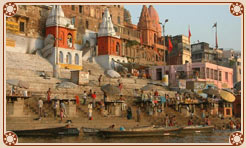 Varanasi or Kashi is older than traditions. Varanasi presents a unique combination of physical, metaphysical and supernatural elements. According to the Hindu mythology, Varanasi liberates soul from human body to the ultimate. It is the Ganga Ghats of Varanasi that complement the concept of divinity. Ghats of Ganga are perhaps the holiest spots of Varanasi. The Ganga Ghats at Varanasi are full of pilgrims who flock to the place to take a dip in the holy Ganges, which is believed to absolve one from all sins.
Varanasi or Kashi is older than traditions. Varanasi presents a unique combination of physical, metaphysical and supernatural elements. According to the Hindu mythology, Varanasi liberates soul from human body to the ultimate. It is the Ganga Ghats of Varanasi that complement the concept of divinity. Ghats of Ganga are perhaps the holiest spots of Varanasi. The Ganga Ghats at Varanasi are full of pilgrims who flock to the place to take a dip in the holy Ganges, which is believed to absolve one from all sins.There are number of temples on the bank of the Ganga river in Varanasi. It is believed that people are cleansed physically, mentally and spiritually at Ganga Ghats. It is at the Ganga Ghats where we see life and death together. For thousands of years people have been thronging these Ghats to offer their morning prayers to the rising sun. There are more than 100 ghats along side Ganga in Varanasi. Some of the prominent and popular Ghats at Varanasi are the Dasaswamedh Ghat, Manikarnika Ghat, Harischandra Ghat, Kabir Ghat and Assi Ghat.
Assi Ghat
Situated at the confluence of Ganga and Asi rivers, Assi Ghat is the southernmost Ghat in Varanasi, where pilgrims bathe before paying their homage to Lord Shiva in the form of huge lingam situated under a peepal tree. Assi Ghat also constitutes the southern end of conventional city. Another lingam worshipped here is the Asisangameshwar lingam representing the lord of confluence of the Asi, enshrined in a small marble temple near the Assi Ghat. It was at the Assi Ghat where the famous Indian poet saint, Tulsi Das had written the much-celebrated Ramcharitmanas.
There are numerous references of Assi Ghat in early literature of the Hindus. We find the mention of Assi Ghat in matsya purana, Agni purana, kurma purana, padma purana and kashi khanda. According legends, Goddess Durga had thrown her sword after slaying the demon, Shumbha- Nishumbha. The place, where the sword had fallen resulted in a big stream, known as Assi River. Assi Ghat is located at the confluence of River Ganga and Assi River. In Kashi Khand, Assi Ghat is referred as Assi "Saimbeda Tirtha" and according to it one gets punya of all the Tirthas (religious places) by taking a dip here. Thousands of Hindu pilgrims take holy dip here in the months of Chaitya (March/ April) and Magh (Jan/Feb) and other important occasions like solar/ lunar eclipse, Ganga Dussehra, Probodhoni Ekadashi, Makar Shankranti etc.
There are numerous references of Assi Ghat in early literature of the Hindus. We find the mention of Assi Ghat in matsya purana, Agni purana, kurma purana, padma purana and kashi khanda. According legends, Goddess Durga had thrown her sword after slaying the demon, Shumbha- Nishumbha. The place, where the sword had fallen resulted in a big stream, known as Assi River. Assi Ghat is located at the confluence of River Ganga and Assi River. In Kashi Khand, Assi Ghat is referred as Assi "Saimbeda Tirtha" and according to it one gets punya of all the Tirthas (religious places) by taking a dip here. Thousands of Hindu pilgrims take holy dip here in the months of Chaitya (March/ April) and Magh (Jan/Feb) and other important occasions like solar/ lunar eclipse, Ganga Dussehra, Probodhoni Ekadashi, Makar Shankranti etc.
Dasaswamedh Ghat
Dasaswamedh Ghat is one of the most important Ghats of Varanasi. Dasaswamedh literally means the Ghat (river front) of ten sacrificed horses. According to legends ten horses were sacrificed by Lord Brahma to allow Lord Shiva to return from a period of banishment. In spite of the fact that Dasaswamedh is one of the oldest Ghats of Varanasi, dating back to many thousand years, the Ghat has remained unspoilt and clean.
Dasaswamedh provides a beautiful and colorful riverfront view. A large number of Sadhus can be seen performing religious rites on this Ghat. Devotees must not miss the opportunity of visiting the Dasaswamedh Ghat in the evening when after Aarti, thousands of earthen lamps are immersed in the waters of the holy Ganges and the floating lamps give a divine look to the river at dusk.
Dasaswamedh provides a beautiful and colorful riverfront view. A large number of Sadhus can be seen performing religious rites on this Ghat. Devotees must not miss the opportunity of visiting the Dasaswamedh Ghat in the evening when after Aarti, thousands of earthen lamps are immersed in the waters of the holy Ganges and the floating lamps give a divine look to the river at dusk.
Harish Chandra Ghat
Harish Chandra Ghat is one of the oldest Ghats of Varanasi. Harish Chandra Ghat is name after a mythological King Harish Chandra, who once worked at the cremation ground here for the perseverance of truth and charity. It is believed that the Gods rewarded him for his resolve, charity and truthfulness and restored his lost throne and his dead son to him. Harish Chandra Ghat is one of the two cremation Ghats (the other being Manikarnika Ghat) and is some times referred as Adi Manikarnika (the original creation ground). Hindus from distant places bring the dead bodies of their near and dear ones to the Harish Chandra Ghat for cremation. In Hindu mythology it is believed that if a person is cremated at the Harish Chandra Ghat, that person gets salvation or "moksha". The Harish Chandra Ghat was somewhat modernized in late 1980's, when an electric crematorium was opened here.
Manikarnika Ghat
Manikarnika Ghat is the main cremation Ghat of Varanasi. Manikarnika Ghat is one of the oldest and most sacred Ghats in Benaras. According to the Hindu mythology, being burned here provides an instant gateway to liberation from the cycle of births and rebirths. Lying at the center of the five tirthas, Manikarnika Ghat symbolizes both creation and destruction. At Manikarnika Ghat, the mortal remains are consigned to flames with the prayers that the souls rest in eternal peace. There is a sacred well at the Manikarnika Ghat, called the Manikarnika Kund. Manikarnika Kund is said to be dug by Lord Vishnu at the time of creation while the hot ashes of the burnt bodies makes one remember the inevitable destruction of everything in the world.
Tulsi Ghat
Tulsi Ghat is another important Ghat of Varanasi. Tulsi Ghat is named after the great Hindu poet of the 16th century, Tulsidas. Tulsi Ghat is an important window into the Hindu mythology. Tulsi Das composed the great Indian epic, Ramcharitmanas at Varanasi. According to mythology, when Tulsi's manuscript fell into the River Ganga it did not sink and kept floating instead. It is also believed that the Ramlila (story of Lord Rama's life) was staged here for the first time. Perhaps, to commemorate this a temple of Lord Ram was built on the Tulsi Ghat. Many of the relics of Tulsi Das are preserved at the Tulsi Ghat. The house in which Tulsidas died has been preserved and his samadhi, wooden clogs, pillow and the idol of Hanuman, which Tulsi worshipped, are all still intact here.
Earlier, Tulsi Ghat was known as Lolark Ghat (mentioned in Gaharwa Danpatra and Girvanapadamanjari). It was in the year 1941 when Tulsi Ghat was made pucca (cemented) by the famous industrialist, Baldeo Das Birla. Tulsi Ghat is associated with a number of important activities such as bath of Lolarkkunda (to be blessed with sons and their long life) and the sacred bath to get rid of leprosy. Tulsi Ghat is also a center of cultural activities. During Hindu lunar month of Kartika (Oct/Nov), Krishna Lila is staged here with great fanfare and devotion.
Earlier, Tulsi Ghat was known as Lolark Ghat (mentioned in Gaharwa Danpatra and Girvanapadamanjari). It was in the year 1941 when Tulsi Ghat was made pucca (cemented) by the famous industrialist, Baldeo Das Birla. Tulsi Ghat is associated with a number of important activities such as bath of Lolarkkunda (to be blessed with sons and their long life) and the sacred bath to get rid of leprosy. Tulsi Ghat is also a center of cultural activities. During Hindu lunar month of Kartika (Oct/Nov), Krishna Lila is staged here with great fanfare and devotion.
River Ganga
River Ganga or the Ganges is a major river of the Indian subcontinent, associated in myth and reality with the land and people of India as well as neighboring countries like Bangladesh. In Hinduism, the river Ganga is personified as Goddess and holds an important place in the Hindu religion. In Hindu mythology, it is believed that bathing in the river Ganga causes the remission of sins and facilitates the attainment of salvation or nirvana. This deep-rooted truth is proved by the fact that people travel from distant places to immerse the ashes of their kin in the waters of the Ganga at Varanasi or other places located on the banks of this holy river. Some of these sacred places, located on the Ganga, are Varanasi, Haridwar and Prayag (Allahabad).
The first Prime Minister of India, Pandit Jawahar Lal Nehru, aptly summarized the importance of River Ganga in the hearts of the Indians, in general, and Hindus, in particular.
"The Ganga, especially, is the river of India, beloved of her
people, round which are intertwined her memories, her hopes
and fears, her songs of triumph, her victories and her
defeats. She has been a symbol of India's age-long culture
and civilization, ever changing, ever flowing, and yet ever
the same Ganga".
The first Prime Minister of India, Pandit Jawahar Lal Nehru, aptly summarized the importance of River Ganga in the hearts of the Indians, in general, and Hindus, in particular.
"The Ganga, especially, is the river of India, beloved of her
people, round which are intertwined her memories, her hopes
and fears, her songs of triumph, her victories and her
defeats. She has been a symbol of India's age-long culture
and civilization, ever changing, ever flowing, and yet ever
the same Ganga".
Muths & Ashrams at Varanasi
For centuries, Varanasi has been home to Indian philosophy, mysticism and spiritualism. Varanasi, therefore, has numerous Muths and Ashrams. At Varanasi different religious outfits have their own Muths and Ashrams. Many of these Muths and Ashrams have survived for centuries and are centers of spiritualism and religious activities. Some of the noted Muths and Ashrams of Varanasi are listed below:
- Dharm Sangh
- Nirajani Akhanra
- Satua Baba Ashram
- Shankaracharya Math
- Jangambari Math
- Sadhu Bela Ashram
- Mata Anandmai Ashram
- Radha Swami Bag
- Kabir Math
- Karpatri Ji Math
- Dandi Swami Math
- RamKrishna Mission Sevashram
- Kinaram Math
- Sanatan Gaudiya Math
- ShriMath, Panchganga Ghat
- Tailang Swami Math
- Gadwa Ghat Ashram
- Gopal Math
- Bhinagaraj Dandi Sevashram
Festivals of Varanasi
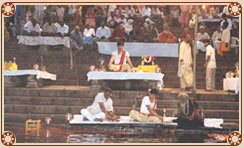 Varanasi is the most popular pilgrimage place for the Hindus. The rich cultural heritage and tradition of Varanasi makes it the cultural capital of India. For ages, Varanasi has been a center of learning of Indian philosophy, spiritualism, mysticism and other branches of education. Varanasi is essentially a melting pot of Indian culture. In Hindu religion, it is believed that one, who dies and is cremated at Varanasi, gets an instant gateway to liberation from the cycle of births and re-births. Being associated with Hindu traditions and religion, Varanasi is home to numerous temples, muths and Ashrams.
Varanasi is the most popular pilgrimage place for the Hindus. The rich cultural heritage and tradition of Varanasi makes it the cultural capital of India. For ages, Varanasi has been a center of learning of Indian philosophy, spiritualism, mysticism and other branches of education. Varanasi is essentially a melting pot of Indian culture. In Hindu religion, it is believed that one, who dies and is cremated at Varanasi, gets an instant gateway to liberation from the cycle of births and re-births. Being associated with Hindu traditions and religion, Varanasi is home to numerous temples, muths and Ashrams.
By virtue of its religious and cultural importance, Varanasi is abuzz with fairs and festivals all round the year. Almost every month, some important festival is celebrated in Varanasi. Besides festivals and holidays, many "Melas" or fairs are also held at Varanasi. At Varanasi, fairs and festivals are celebrated with traditional gaiety and fervor and are symbolic of celebration of life at its best. The festive atmosphere never seems to end in Varanasi. It's not important to make itinerary according to the dates and months as one can come and enjoy the festive season of Varanasi anytime of the year!
Climate of Varanasi
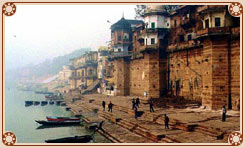 Situated in Uttar Pradesh, in northern part of India, Varanasi is located on the banks of the holy river, Ganges. During summers, weather can be as hot as 45° C and humid too as Varanasi lies at the Tropic of cancer. Torrential rains and high humidity accompanies the monsoons that usually come in late June or early July for about two months. Delicious and juicy mangoes offer little relief from the sweating weather. On the other hand, winters are pleasant and temperature dips down to about 7°C. In Varanasi, the climatic conditions are most favorable for the tourists between October to April. For those who are ready to face a sun and don't mind the odor of sweat, Varanasi is a place to visit all the year round.
Situated in Uttar Pradesh, in northern part of India, Varanasi is located on the banks of the holy river, Ganges. During summers, weather can be as hot as 45° C and humid too as Varanasi lies at the Tropic of cancer. Torrential rains and high humidity accompanies the monsoons that usually come in late June or early July for about two months. Delicious and juicy mangoes offer little relief from the sweating weather. On the other hand, winters are pleasant and temperature dips down to about 7°C. In Varanasi, the climatic conditions are most favorable for the tourists between October to April. For those who are ready to face a sun and don't mind the odor of sweat, Varanasi is a place to visit all the year round.Pilgrimage in Varanasi
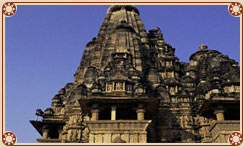 |
Kashi Vishwanath Temple, Varanasi |
Dedicated to Lord Shiva, the temple has earned the name of Golden Temple due to the gold plating done using one ton of gold donated by Maharaja Ranjit Singh on its 15.5-m high spire. Invaders destroyed the original temple and Rani Ahilyabai of Indore rebuilt it only in in 1776. Again, the fanatic Mughal Emperor Aurangzeb destroyed the Vishvanath temple to replace it with the Gaynvapi Mosque. However, one can still see the remnants of the temple in the intricate and fine artwork of the western wall of the mosque. Today, the Kashi Vishwanath Temple and the Gyanvapi mosque lie adjacent to each other.
Vishwanath Temple
The Kashi Vishwanath temple is located in the heart of the cultural capital of India, Varanasi. It stands on the western bank of India's holiest river Ganges. The Kashi Vishwanath temple is the center of faith for millions of Hindus. The Jyotirlinga of Shiva, Vishweshwara or Vishwanatha, is enshrined in the Kashi Vishwanath temple, considered as one of the holiest temples of India. In Hindu religion it is believed that a simple glimpse of the Jyotirlinga is a soul-cleansing experience that transforms life and puts it on the path of knowledge and Bhakti (devotion). A single darshan of Vishweshwara Jyotirlinga is considered to merit more than the darshan of other jyotirlingas, scattered in various parts of India. The Kashi Vishwanath Temple has been a living picture of the timeless cultural traditions and highest spiritual values.
The Kashi Vishwanath Temple attracts Hindu devotees and other visitors not only from India but also the world over. Lord Vishwanath is considered the supreme repository of the spiritual truth and strengthens the bonds of universal brotherhood. Late Maharani Ahilya Bai Holkar of Indore built the temple in the present shape, way back in 1780. In the year 1785, a Naubatkhana was built up in front of the Temple at the instance of Governor General, Warren Hastings. In 1839, two domes of the Temple were covered by gold, donated by Maharaja Ranjeet Singh, the ruler of Punjab. The management of the Kashi Vishwanath temple rests with a trust.
The Vishwanath temple opens daily at 2.30 A.M. for Mangala Aarti and between 3 to 4 A.M. ticket holders are permitted to join. The timing of general Darshan is from 4 to 11 A.M. The timing for midday Bhog Aarti is from11.30 to 12 A.M. Between 12 noon to 7 P.M., general devotees are free to have Darshan. From 7 to 8.30 P.M. the Sapta Rishi Aarati is held after which Darshan is possible again till 9 P.M. At 9 P.M. the Shringar/Bhog Aarati starts and after that Darshan is possible only from outside. Shayana Aarti starts at 10.30 P.M. and the temple closes at 11 P.M. Most of the offerings at the Kashi Vishwanath temple are given to poor.
The Kashi Vishwanath Temple attracts Hindu devotees and other visitors not only from India but also the world over. Lord Vishwanath is considered the supreme repository of the spiritual truth and strengthens the bonds of universal brotherhood. Late Maharani Ahilya Bai Holkar of Indore built the temple in the present shape, way back in 1780. In the year 1785, a Naubatkhana was built up in front of the Temple at the instance of Governor General, Warren Hastings. In 1839, two domes of the Temple were covered by gold, donated by Maharaja Ranjeet Singh, the ruler of Punjab. The management of the Kashi Vishwanath temple rests with a trust.
The Vishwanath temple opens daily at 2.30 A.M. for Mangala Aarti and between 3 to 4 A.M. ticket holders are permitted to join. The timing of general Darshan is from 4 to 11 A.M. The timing for midday Bhog Aarti is from11.30 to 12 A.M. Between 12 noon to 7 P.M., general devotees are free to have Darshan. From 7 to 8.30 P.M. the Sapta Rishi Aarati is held after which Darshan is possible again till 9 P.M. At 9 P.M. the Shringar/Bhog Aarati starts and after that Darshan is possible only from outside. Shayana Aarti starts at 10.30 P.M. and the temple closes at 11 P.M. Most of the offerings at the Kashi Vishwanath temple are given to poor.
St. Mary's Church:
Situated in the cantonment area of Varanasi, the architectural peculiarity that distinguishes St. Mary's Church from others are its louvered doors and hooded ventilation. It has a low tower, spire and projecting portico. The church looks beautiful with its plain timber canopy protecting the rectangular fanlight above each doorway and also impresses a major architectural impact.
Durga Temple:
The 8th century Durga temple is built in Nagara Style and is one of the most important temples of the city. The 'shikhara' of the temple consists of several small spires layered one on top of the other.
Bharat Mata Temple:
Dedicated to Mother India, it is situated in Mahatma Gandhi Kashi Vidyapeeth. It was built by Babu Shiv Prasad Gupt and inaugurated by Mahatma Gandhi in 1936. The statue marble of Mother India shows undivided India with mountains, plains and oceans in exact proportions.
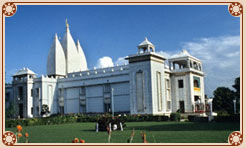 |
Tulsi Manas Temple, Varanasi |
Dedicated to Lord Rama, this temple is said to be built on the site where Goswami Tulsidas wrote the epic 'Ramacharitramanas'. It was built in 1964 by a philanthropist family.
Nepali Temple:
Built in Nepali style by the King of Nepal on Lalita Ghat, it is also known as the Kathwala temple because of the magnificent woodwork. Tourist attraction for visitors from all over the world, it is said to be incomparable to any other temple in India. It is said that the workers and the wood was imported from Nepal to build this temple and the its specialty is that termites do not eat the wood used to construct it.
General Facts About Varanasi
Languages Spoken: | Hindi, Sanskrit and English |
STD Code: | 0542 |
Population: | About 14 lakh. |
Distance From: | |
Jaunpur: | 65 km |
Chunar: | 40 km |
Sarnath: | 10 km |
Kaushambi: | 180 km |
Caution for Tourists:
- Beware of touts that pose as 'Pundits' on the Ghats to extract money from the devotees to perform religious ceremonies.
- Check for fare and the route before hiring a rickshaw and auto to move around in the city.
- Beware of agents between the buyers and sellers of handicraft items.
- Incidents of snatching and pick pocketing have been heard in the temples so take care that you keep your valuables in hotel itself.
- Arms and ammunitions are not allowed inside the temples for security reasons, especially in the Kashi Viswanath temple or Gyanvapi Mosque.
No comments:
Post a Comment